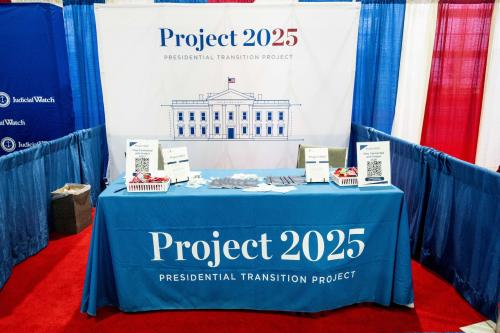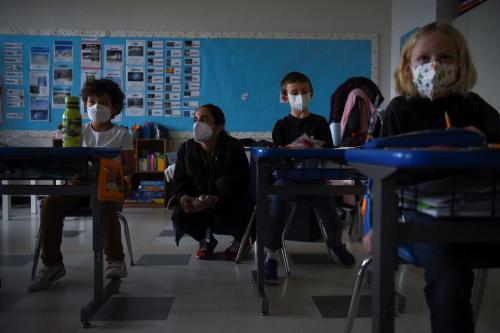For those who thought K-12 education would be sidelined from this year’s presidential race, we’ve gotten a couple of twists.
One twist is a proposal to dismantle the U.S. Department of Education emerging as a campaign issue. Republicans have floated the idea over the years, but it captured the public’s attention—and concern—when it became the focal point of a Project 2025 chapter. Another twist is Kamala Harris’ selection of Tim Walz as her running mate. Walz is a former teacher who frequently cites his work on schools and parent supports as Minnesota’s governor. At a time when Democrats have seemed reluctant to talk about K-12 education, Walz provides an invitation—and a voice—to rejoin the discussion.
It’s an invitation that Democrats should accept. Ever since Republicans started landing their critiques that Democrats were too slow to reopen schools during the pandemic, Democrats have seemed reluctant to engage on K-12 education. Republicans noticed the timidity. Finding little resistance from Democrats on K-12 issues, Republicans repeatedly looked to schools as their preferred battleground for culture war conflicts over race, gender, and sexuality. The consequences included a wave of anti-LGBTQ+ policies, politically tinged curricular reforms, and statewide private school voucher (or ESA) programs.
In pushing for these reforms, Republicans offered “parents’ rights” as their guiding principle. Since Democrats weren’t paying attention to parents’ concerns, the argument went, Republicans would fill the void.
It’s true that social policy in the U.S. isn’t parent friendly, and Democrats share some blame for that. But parents’ rights advocates operationalized their vision in a particularly narrow, cruel way. They emphasized parents’ “right” to protect children from ideas, people, and materials that make some parents uncomfortable. That meant designing education policy around goals like slaying a critical race theory boogeyman and keeping transgender students from choosing their own pronouns. That came at an especially bad time, when leaders should have been focused on pandemic-related issues.
Still, there’s something to the idea that we need more parent-friendly policies. Parenting is rewarding and exhilarating. It’s also exhausting, anxiety-inducing, and expensive. Policymakers can’t lift all that weight from parents’ shoulders, but they can lighten the load.
Interestingly, if you squint as you read what Democrats and Republicans are saying about supporting parents, you might see opportunities for collaboration. That’s not necessarily bipartisan compromise in the traditional sense. It’s more like what Lorén Cox and Karen Nussle of the Aspen Institute call “cross-partisan” collaboration, which embraces the possibility that collaborating parties will have different goals for their joint work (i.e., agreed-upon means to different ends).
That’s the purpose of this piece: to explore the possibility of a cross-partisan policy agenda to support parents of school-age children.
Rethinking parents’ rights (or expectations)
Let’s stick with the idea of articulating some basic rights for parents. Or, more precisely, let’s think about what parents should reasonably expect from policymakers as their children move through their K-12 years.
I’ll focus on areas where it seems like there could be some cross-partisan (or bipartisan) agreement, and I’ll try to identify specific policy actions (underlined below). To keep this manageable, this piece focuses on parents of school-age children (setting aside important issues like parental leave) and federal policy (setting aside state, local, and school-level actions).
Here’s my list:
1. A basic level of financial resources
One of this election’s more interesting policy questions involves financial support for families with children. Democrats tend to frame the idea in terms of ending the scourge of child poverty and making child care more affordable. Republicans also point to child care affordability, sometimes as an engine for economic growth, and are increasingly raising alarms about falling birthrates. (There’s also J.D. Vance’s odd framing, which emphasizes punishing non-parents rather than supporting parents.)
Despite those differences, leaders of both parties are expressing support for an expanded child tax credit. In fact, it’s a pledge in both the Democratic and Republican platforms. There are details to iron out regarding the size of the credit, possible phaseouts for high earners, and possible work requirements. Still, there’s plenty of room to get something done—and plenty of empirical support that it’d (again) have positive effects.
In addition to expanding the child tax credit, supporting other public assistance programs like SNAP, TANF, Medicaid, CHIP, and Summer EBT would shield children from poverty while likely generating long-term benefits to society.
2. Physical health and safety at school
By and large, U.S. public schools are safe places for children, where rates of victimization have declined markedly in recent decades. At the same time, school shootings have continued at a horrifying rate—and continue to weigh on the minds of students, families, and educators.
As one shooting after the next passes without a meaningful policy response, it’s fair to be cynical. The fact remains, though, that a large majority of Americans support gun violence prevention measures like increasing the minimum age for buying guns to 21 years, banning assault weapons, and requiring background checks for gun buyers (ideas embraced both by advocates and experts). The federal government also can provide guidance and resources to schools to improve mental health supports and safety measures. For example, it might be time for another try at a federal school safety commission after the Trump-era version accompanied some reasonable, apolitical ideas with some not-so-reasonable, partisan ones.
Other threats to students’ physical health are harder to see. A growing body of research shows the far-reaching harms from children’s exposure to school bus emissions, lead, and other pollutants. Federal investments to modernize school infrastructure and electrify school bus fleets are well supported by research. And protecting kids from toxins shouldn’t be a hard case to make to parents of any political stripe.
3. Evidence-supported curriculum and teaching practices
Some of the fiercest conflicts in K-12 education have been about what schools teach, especially in subjects like U.S. history and civics. At the same time, we’ve seen important changes in what (and how) schools teach that didn’t cause big, public clashes along party lines. This includes a shift towards a more evidence-based “science of reading,” which Cox and Nussle cite as a prime example of cross-partisan work. The growing push to ban cell phones from classrooms may be another example.
Even if Americans continue to disagree about how schools should teach more values-laden subjects, that leaves many subjects like math and reading where parents care far more about how well their kids are taught than how they’re taught. Frustratingly, though, the evidence on “what works” in teaching these subjects is often lacking. That’s partly because there just isn’t enough rigorous research that evaluates curriculum (with some exceptions), and it’s too hard to find the research that’s out there.
This leaves state, district, and school leaders to make curriculum purchases with little evidence to guide them beyond the “research” reported by the curriculum companies themselves. If you’d like to put yourself in these leaders’ shoes for a moment, imagine that you’re making an important decision about whether to procure a certain curriculum or technology (maybe Eureka Math or IXL). Try searching the U.S. Department of Education’s What Works Clearinghouse for evidence on the program you’re considering. I bet you won’t find much.
The federal government could be more helpful here. Research on curriculum—in particular, on new, AI-assisted programs—should comprise a larger share of the Institute of Education Sciences (IES) funding portfolio. Where IES funding goes, researchers follow. And when that research is published, the U.S. Department of Education needs to actively disseminate it and make the research easily searchable.
4. Student privacy protections
The core legislation that protects student privacy in the United States, the Family Educational Rights and Privacy Act (FERPA), turned 50 years old last month. It’s gotten dusty over the years. Today’s technologies, coupled with the omnipresence of third-party companies in U.S. schools, have drastically changed the risks and possibilities of data breaches. For example, FERPA’s writers weren’t thinking about students revealing personal thoughts and information—including images and audio—to AI-powered chatbots run by private companies that might turn and sell those data. But that’s the nature of privacy risk in 2024.
It’s time to update FERPA and other relevant privacy legislation (such as the Electronic Communications Privacy Act). The Democratic platform contains a pledge for bipartisan legislation in this area. On the right, even groups like Moms for Liberty are raising concerns about data privacy, albeit with a very different framing.
5. Protections for the most vulnerable students
Instead of protecting vulnerable students from harm, the parents’ rights movement has seemed more interested in “protecting” parents and their kids from vulnerable students. For example, it has prioritized a parent’s supposed right to keep their children from being exposed to LGBTQ+ or nonwhite literary characters over another child’s opportunity to see their identities represented and embraced at school.
It might take some extra-hard squinting (or maybe a refresher on Rawls’ veil of ignorance) to find opportunities for cross-partisan collaboration to protect vulnerable students. But there are points of agreement. For example, the vast majority of Americans oppose book bans and support teaching about race in schools.
To start, the federal government should provide the U.S. Department of Education’s Office for Civil Rights with the resources it needs to fulfill its core mission (enforcing federal civil rights laws that prohibit discrimination against protected groups). It also should more fully and sensibly fund the Individuals with Disabilities Education Act and Title I. Red states, after all, rely on Title I funds just as much as blue states.
6. Respect for parents’ time
Time is a precious commodity, and parenting is nothing if not time-consuming. That should be on the minds of policymakers and administrators as they design school policies, programs, and processes. American parents lose too much time—and too many opportunities—to needlessly burdensome activities. That includes navigating school choice processes, applying for gifted programs, and just enrolling in school. Administrative burden scholars have shown the costs of this “time tax,” and it’s been a point of emphasis for the Biden administration (with, shall we say, limited success in simplifying the FAFSA).
I’ve gotten a taste of this “time tax” through an ongoing, Louisiana-based project that aims to reduce the burdens associated with applying for public assistance programs like SNAP, WIC, and free pre-K. One interesting, early lesson from that work is that there’s opportunity for cross-partisan collaboration; what some see as a promising way to improve access to critical services, others see as a promising way to reduce government waste.
The federal government can provide resources and guidance to help states build integrated, streamlined public benefits applications. Additionally, for federally funded programs like WIC and Head Start that are run at the local or state level, the federal government’s eligibility and application requirements are a frequent source of frustration for parents and administrators—and cause of program underutilization. The federal government should reassess these requirements with an eye on eliminating unnecessary burden. This includes working with local and state leaders to align eligibility and paperwork requirements across programs and create more standard, cross-program approaches for determining income and household size.
Another possibility for time savings: free, universal school lunch. As governor, Walz signed a bill in 2023 to provide school lunch to all Minnesota students regardless of family income. That means time savings for parents tasked with making lunch every morning. It also could mean less paperwork for families and school administrators, along with—most importantly—less food insecurity and better student performance and attainment. There’s potential for more federal action in this area, too, though Republicans seem wary.
Of course, all of this is easier said than done. The bottom line, though, is that there are real, cross-partisan opportunities for improving supports for parents of school-age children. Those opportunities are well worth pursuing no matter who is elected this fall.







Commentary
Moving from a ‘parents’ bill of rights’ to a cross-partisan policy agenda to better support parents
September 24, 2024